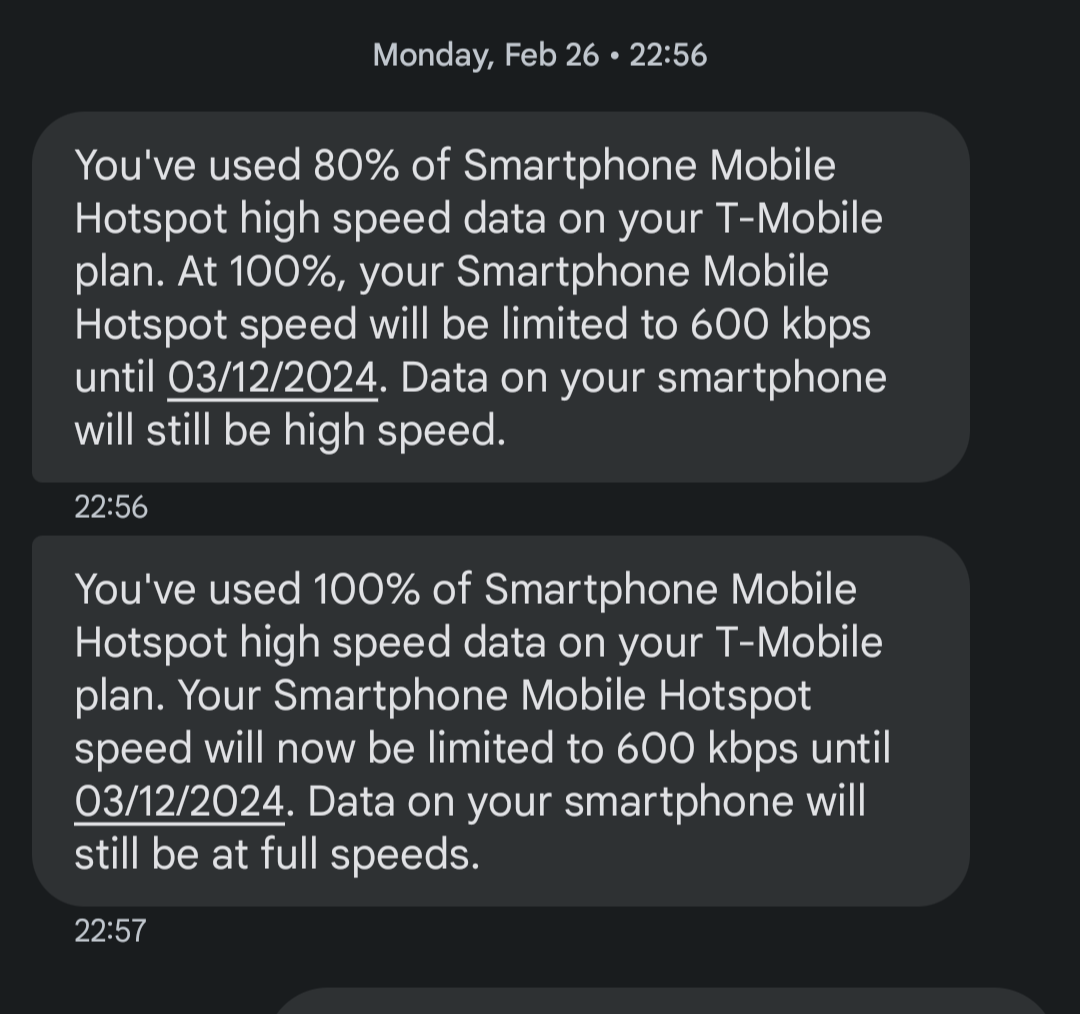What is the difference between cellular data being used on my phone and cellular data being used on my notebook? Data is data.
Basically they don’t want you to turn your phone into a mobile router.
Well then don’t offer unlimited data. Is it unlimited or not?
Unlimited data, not unlimited speed. It didn’t say they’d cut you off, only that you’d be throttled.
(Yes it’s an asshole move but there is a difference)
Unlimited is by definition without a limit
5 GB is a limit
You have “unlimited data” so you can download all you want. You do not have “unlimited bandwidth”.
Unlimited data for your phone, not your computer.
Definitely not the way they structure it currently
How do they know if the source of data is hotspot? I’d imagine there is a way to stop your phone grassing on you.
You have to turn that feature on.
Could you install a different OS like suggested here https://dubvee.org/comment/1855949 / by Admiral Patrick below?
Yeah, installing a new OS on a phone isn’t something you do easily like on a PC.
You have to unlock the bootloader, which requires an unlock code from the manufacturer, then you have to factory reset it, and that’s even if your phone/carrier allows it. Many don’t (which is why it’s so hard for me to replace my phone…grrr).
So yeah, installing a new OS on your phone is typically going to require quite a bit of effort and some level of commitment as well as a device that’s bootloader unlockable and supported by an alternate OS (each device and model requires a custom build).
It’s…a whole thing. It really shouldn’t be, but it is :(
I haven’t done it in a while, but it kinda depends on the phone, some were very easy to flash in the earlier days of Android.
Yeah, my old Moto Play G4 was a breeze. Wasn’t quite “Press any key to continue” but not much more difficult.
My OnePlus was a little more work, but that was mostly because of the OP website acting up and refusing to generate my bootloader unlock key. Also had to do things differently since it didn’t have an SD card to hold my install stuff like the Moto Play did.
I had one where you could literally run an app on the phone, no ADB or anything. Can’t remember what phone it was now but it might’ve actually been a Moto Droid
One one hand, that sounds extremely convenient. On the other, I shudder thinking what a malicious app could do with that 😆
Edit: Unless you’re talking about doing it through TWRP. I had to flash that over fastboot, but once installed to the recovery partition, I could boot into that and install the rest of Lineage and extra packages straight from the SD card. Updating the system was just downloading the new Lineage .zip to the SD card, booting into TWRP, and clicking install.
and that’s even if your phone/carrier allows it.
This is why you should buy the phone outright yourself then get a SIM only deal, rather than paying for your phone in contract.
Yeah I do, but SIM unlocked and bootloader unlockable are two different things. Sadly, not every phone (or even the same phones made for different carriers) are allowed to be bootloader unlocked; I have no idea why, but it is and sucks.
Yeah it’s definitely true, even with the same manufacturer it can be hit and miss. You gotta do your research before you buy.
Maybe, but it’s not worth it just for a few days, which is all I’ll need it for. I just forked over $15 for another 10 gb.
$15 for 10GB?! USA phone bills are extortionate!
Lol when I travel to the US I get 12GB roaming per month included for no extra charge.
I just have unlimited data in 200 countries on Fi in the US.
You think our phone bills are extortionate? Try Canada. They’re worse. Which is really saying something.
Yeah, it really sucks, but at least there aren’t roaming charges anymore.
It’s worth it for more than a few days, custom ROMs ftw.
Personally my minimum features are:
- Long press back button to force close and kill an app.
- Call recording.
All the other stuff and customisation is just tasty gravy.
There’s different internal network configs (APNs), and hotspot uses a different one than regular mobile data. ( or at least it used to). Those can be configured and metered separately from the carrier’s end.
LineageOS, and maybe some other custom ROMs, wouldn’t do that and would put the hotspot and mobile data on the same APN to get around that.
Even on my unlocked, non vendor phone it seems to not recognize hotspot data as different for some reason.
I’m still hoping for LineageOS on the Nord N30 but I can’t Even find a stock ROM to root it.
Can confirm, switching to Graphene solved this problem for me a long while ago.
Ugh. I was dumb and got a Samsung that was offered to me for cheap on the spot. If I had done any research I would have learned that there’s no alternative OS options. Now I’m stuck with it, because I’m poor, so I just try to avoid using it. I should keep an eye out for something used that’s compatible.
While it’s not at the same level as Graphene OS, Samsung is pretty well supported by Lineage OS. AFAIK at least in Europe Samsung phones have an unlockable bootloader, but YMMV.
Nah. Nobody’s figured out how to access the ROM on my specific model, unfortunately, and I’m 900% sure Canadian telecom oligopolists will not be cool about unlocking like that.
In my defense, if it was a laptop it would have been much less foolhardy.
Doesn’t unlocking the bootloader break Google Pay?
You can in theory still use Google Pay with a Magisk module called Play Integrity Fix and using a fingerprint from a different phone to pass Basic and Device integrity. I’m currently doing it on my Pixel 7 Pro.
But it has a steep learning curve and is a temporary solution that will disappear in roughly a year once Google sunsets legacy integrity methods and starts requiring Strong integrity, which can’t be faked under known methods. Google is also actively disabling fingerprints that are being spoofed, making the whole thing frustrating and even more temporary even when it works.
Just let us use our devices, sheesh.
Don’t know, wouldn’t touch that with a 10 foot pole.
What’s wrong with Google Pay?
the Google part
You can lock the bootloader again after the flashing process is done(because it will add the signing key of the new OS), but unfortunately the NFC Payments in Google Pay still won’t work because Google only allows it on ‘certified’ Android systems (aka only the preinstalled OS)
Isn’t this dependent on the ROM, like lineage shouldn’t be locked where as calyx is locked likewise for graphine os
Yes, afaik LineageOS shouldn’t be locked, but I was talking about GrapheneOS specifically because @wesker@lemmy.sdf.org was talking about that.
Back when they just began recognizing it, they noted peculiar traffic. Desktop websites, batch downloads normally unavailable to that system. This assumes that you utilized the internal hotspot system and didn’t create a separate one. Now? Not sure whether their system is more robust but it should, theoretically, be possible to obfuscate your traffic using third party hotspot software. No clue where to look for that anymore.
I used to routinely use 100gb of data on my jailbroken sprint iPhone. Did that for almost 3 years. Never heard a peep from them. But this was forever ago.
That was great, and you didn’t have to pay some extra tethering fee every month either (or something like that, it was so long ago for me).
If you used the package I think you did, that’s not unusual. Absolutely will not remember the name but there were numerous tweaks that just flipped the hotspot switch but a couple that allowed you to use a hotspot without directly using the inbuilt function. One was free and broadly used.
If you root your phone and install a custom rom, you can get around it and they can’t tell.
If you’re factory, it sends that hotspot info to them.
TTL in the packet header is 29 instead of 30
Well that’s an easy fix.
This is why we need net neutrality
Net neutrality isn’t going to do a thing about this kind of stuff. In a best case scenario, you’ll end up with overall data usage limitations - no more ‘unlimited mobile data’.
ISPs meter data usage because it’s pretty much the only way they can impose some form of limitation on a finite capacity to provide such data to you and other customers - other than data rate limits (read: slower speeds). They can’t guarantee data rates in almost any setup, because ultimately, while ‘data usage’ is a bit of an artificial construct and ‘data’ is not in any way finite, the pipes that deliver the data certainly are of finite capacity. Mobile data capacity - and in fact, any wireless medium - is a shared medium, the more people try to use it simultaneously, the less pleasant it’s going to be for each individual user. Ask Starlink users in many US areas how overselling limited capacity impacts the individual user.
Mobile data usage also has different usage patterns than if you’re hotspotting your PC. You’re not going to download massive games or other bandwidth hogs to your mobile. You probably won’t be running a torrent client either. So they can give you unlimited mobile data because you’re simply not going to put as much of a strain on the infrastructure with pure on-device usage than you will with hotspotting.
This isn’t a defense of what AT&T is doing. But net neutrality isn’t going to force them to suddenly be all ethical. It’s not going to make them provision infrastructure that doesn’t fall over at the first signs of higher-than-usual load. And it certainly can’t change the physical realities of wireless data communication. In an ideal world ISPs wouldn’t be so greedy and/or beholden to greedy shareholders to be cutting corners, and instead provide sufficient infrastructure that can handle high demand.
And to those who are talking about their workarounds: you may not like it but you’ve signed a contract. That contract stipulates acceptable use, and if you’re found to be breaching the contract terms, the other party is within their rights to terminate the contract. Again, in an ideal world these contract terms would be more balanced towards the needs of the customer, but in the meantime your best recourse against unfavourable contract terms is to take your business elsewhere. And if you can’t do that, everything else is at your own risk.
If they didn’t have the bandwidth, I don’t think T-Mobile would offer home Internet and advertise it as much as they do
But where are they offering it? Big cities and densely populated areas where people have options and therefore won’t swarm to the product? Or are they offering it in small, remote towns where there’s not a lot of competition?
Where I live, mobile home internet is not available outside of metro areas and larger cities, and in the regions mobile towers are chronically underprovisioned and overloaded.
That’s not what net neutrality does, and I’m disturbed by this being the number one comment.
Are you talking about net neutrality in general, or a specific campaign that used the term? Net neutrality means all bits are equal. It does not matter where a bit is coming from, where it is going to or what it is part of.
No portion of any net neutrality bill anywhere calls for hotspot data to not be capped by a cell carrier. It doesn’t eliminate any caps for anything at all. Net neutrality means they can’t change the speeds dependant on what sites you’re accessing and that they can’t block any sites, give free data to access some sites and not others, or put them behind a pay wall. It has nothing to do with general hot spot data caps, or cell phone data caps.
This has little to nothing to do with net neutrality, which refers to back end L1 and L2 network interconnections.
what are you talking about? that makes no sense
Edit: wait, you might be right. As I understand, net neutrality is for the last mile ISPs, not the L1/L2 providers. So uh… what I explained below isn’t relevant. Eh, I’ll leave it in case people wanna learn stuff.
It was a bad explanation, assuming you had knowledge of network infrastructure things, but it does make sense. I’ll explain things if you’re interested.
Net neutrality is the idea that ISPs must treat all content providers equally. Your phone is not a content provider (most likely. You could run a web server on your phone, but… no). YouTube, Netflix, Facebook, TikTok, and your weird uncle’s WordPress site are content providers. Without net neutrality, ISPs can say, “Hey YouTube, people request a ton of traffic from you on our network. Pay up or we’ll slow down people’s connections to you.” The “neutrality” part means that ISPs must be neutral towards content providers, not discriminating against them for being high demand by consumers.
For the L1 and L2 part, that’s the networking infrastructure. The connection to your home is just tiny cables. I don’t recall how many layers there are, but it’s just “last mile” infrastructure. The network infrastructure between regions of the country or across the ocean are giant, giant cables managed by internet service providers you’ve never heard of. They’re the kind of providers that connect AT&T to Comcast. These are considered L1 or L2 providers. The data centers of giant companies, like Google for YouTube’s case, often pay these L1 or L2 providers to plug directly into their data centers. Why? Those providers are using the biggest, fastest cables to ferry bits and bytes across the planet. You might be pulling gigs from YouTube, but YouTube is putting out… shit, I don’t even know. Is there a terabyte connection? Maybe even petabyte? That sounds crazy. I dunno, I failed Google’s interview question where they asked me to estimate how much storage does Google Drive use globally. Anyway, I hope that gives you an idea of what L1 and L2 providers are.
I’m not a network infrastructure guy, though. If someone who actually knows what they’re talking about has corrections, I’d love to learn where I’m wrong
Net neutrality is about service to last mile customers, but it is based upon interconnection agreements across the L1 and L2 level.
ISP’s pay for a connection to L1 and L2, so their users (who pay ISP’s) can access content on those networks. Websites pay for a connection to L1 and L2 so their content can be available on those networks.
ISP’s want to also charge websites for access into their networks of users, in spite of the fact their users already pay them for access to the website content. If some websites don’t pay, then ISP’s will provide a lower service to their users for those websites. Net neutrality says ISP’s should not do this.
Differentiating between locally used data and hotspot data has nothing to do with this. Hotspot data is about the device the data is going to, not where the data is coming from, and typically (or at least traditionally, maybe not so anymore) a PC will use more data than a phone. A PC is more likely to have large multi-gigabyte downloads (eg games), although these days video streaming is perhaps the main bandwidth hog and is generally equal across all devices.
A home internet connection is expected to serve all devices in that home, while a mobile internet connection is expected to serve only that mobile device (excluding mobile broadband options, which serve multiple devices but are typically more expensive). The ISP’s network is designed with this in mind.
It is more reasonable for an ISP to only provide data to the phone you’re paying for than it is for them to throttle websites you already paid for. However, really both are kind of bullshit - usage limits in general are completely disproportionate to actual costs.
100% this
Sorry how would net neutrality do anything but make them reword the policy??
The ISP shouldn’t care what kind of traffic is going through the network and show it down by type. It should be neutral to it
Right… they can still impose data caps. They’ll just do the cap at the plan level, like most already do. OPs just on a cheap plan.
They can care about what device they’re providing internet to. Net neutrality is about where content is coming from.
They provide internet to the phone. What the phone does with it (e.g. provide a hotspot), is another story.
That depends on whether the connection is sold to cover one device or several.
And more competition.
T-Mobile hasn’t done this for years. Att is just shit
When T-Mobile moved to unlimited with the ONE plans, they gave You “unlimited” tethering at “3G speeds”, which turned out to be 0.5Mbit/s, an unusably slow speed in 2018.
The Magenta plans gave you 5GB-50GB of full-speed tethering before dropping you to “3G speeds”. The current Go5G plans are similar, with a limited amount of usable tethering data before you’re, for all practical uses, cut off.
Before the ONE plans, there technically was no hotspot usage limit, but since you had a limited amount of high-speed data, your hotspot was effectively limited to whatever your plan gave you.
All the US carriers limit hotspot usage, partly to prevent someone hooking up a computer to download 50TB of pirated movies while clogging up the bandwidth for everyone else on that tower, and (moreso) partly because they’re greedy.
If it were just bandwidth issues, they’d only limit you during times of congestion.
It’s pure greed.
3g speeds are fine, no clue what you’re talking about. I literally tether all the time and when I hit the limit it’s still completely usable, even for YouTube. And getting to that limit is well above the 5gb from ATT. Like I said, att is shit, T-Mobile doesn’t do this and hasn’t for years.
Literally every carrier on the planet limits hotspot data in some manner. This isn’t a US thing.
I have T-Mobile. They absolutely do.
I have T-Mobile, they absolutely don’t.
Uh?

Lol. They totally do. Their best plan without going arm and a leg for unlimited gives you 50GB a month before dropping to near nothing. Up to a year ago it was 40GB.
50gb is not even close to 5gb and 3g speeds are not even close to 128kbs so no, T-Mobile doesn’t do this.
T mobile has low GB plans that are far less than 40 or 50 GB and 3g is capable of over 3Mbps, so I don’t know what dumbassery you’re talking about.
128kbps is referring to the ATT limitation so you’re just proving my point. T-Mobile doesn’t do what att does.
Nationalize the tubes
Which is bullshit. Who cares if you download something at full speed on your phone or through the hotpot? A bit is a bit, doesn’t matter where it ends up when received by the phone’s modem.
It’s a sneaky way of having a bandwidth cap without having a bandwidth cap. Mobile devices have smaller storage, so you’re less likely to use as much bandwidth compared to a laptop. Also a single device going to use less data than multiple devices sharing a hotspot.
You can burn through a huge amount of data streaming 4K video on your phone without using any storage. You can also plug a 20TB USB hard drive into your phone, connect to a VPN and torrent away.
But most users don’t. And that’s what they’re counting on.
Jokes on them, I have a 512GB micrSD card and I use Termux to archive videos through YT-DLP.
Was just going to say… my phone has 512GB storage and can do direct WiFi file transfer to my computer without a hotspot. All without using the mobile hotspot feature.
The carrier who’s paying for your traffic. You’re most likely going to use a lot more data on a computer than actually on your phone.
The carrier who’s paying for your traffic.
soooo… what’s with the monthly bill then?
I mean let’s be real, it’s incredibly complex and amazing technology. Borderline magic. And depending on where you are, yeah consistently using large amounts of bandwidth can and will impact other users.
So a policy like this makes sense, to a point. It’s when they auto charge you for hitting a “limit” that grinds my gears.
And I’m sure we can all acknowledge what would happen to prices if there were zero restrictions. A top budget blogger tip would be “stop paying for your expensive broadband service! Plug your phone in and tap “hotspot” in settings to save $50-$100 a month.“
Normies (grandmas using Facebook, not WFHers/gamers) would be frivolous to pay for two “equivalent” Internet services.
(Before you think me a corporate lobbyist, know I submitted a complaint to the FCC when Comcast first implemented broadband bandwidth caps in the USA. Saw that BS in Canada.)
Less than it would be if they expected you to go full ham 24/7.
Username checks out.
If you use a VPN it can also mask it too. That’s how I used to get around it before moving to Google Fi.
Same, if I have unlimited data it’s none of their business what that data is
The difference is one hop. I think that’s how ISP’s measure it anyway. I’ll bet spoofing that number would bypass the restriction.
Or I’m hopelessly out of date.
Something like that, yeah. I recall a while back that TTL spoofing was a way to get around that kind of detection. Haven’t had to deal with that lately, so no idea if it’s still valid / applicable.
AT&T are like:
Here is an alternative Piped link(s):
https://piped.video/DHgVRVeRNXM?feature=shared
Piped is a privacy-respecting open-source alternative frontend to YouTube.
I’m open-source; check me out at GitHub.
I’ve read somewhere that USB tethering bypasses this very easily.
Is easytether still a thing? That app saved my butt several times.
I’m not sure tbh, my ISP doesn’t throttle my speed or data when used as a hotspot, luckily, so I didn’t have to look into it for a long time.
Does it? Interesting. I’ll have to try that. I wonder why?
From what I heard is that a phone used as USB tether identifies as a modem on the computer, and then the traffic is somehow detected differently. I haven’t tested this personally though since my ISP doesn’t cap or throttle me when using hotpsots.
There used to be other ways to bypass it as well, like PDAnet, rooting, flashing custom OSes, etc.
deleted by creator
Have you tried running a vpn to your phone while tethering?
https://moonpiedumplings.github.io/guides/unrestricted-tethering/
I experimented with it a little bit, but it didn’t go anywhere when I discovered my phone already proxies/NATs all my traffic.
I got hit by this AT&T usage cap for internet downloads. I went through 250GB of downloads in less than a month. Most of it was internet backups of a newly installed system. They don’t offer a data tier without a cap in my area so I was stuck paying $10/10GB over that month. Next month I added a $30 unlimited data charge to my bill. That’s OK as I’m consistently going over their cap again due to backups. Unless I buy much more expensive plan from a commercial provider and pay for Fibre installation, I’m stuck.
I’m sure this is an unpopular opinion, but I kind of get this one. Unlimited data on your phone is constrained a bit because it’s your phone. If you make your phone a hotspot and the whole family is using it to watch videos and stuff (and not paying for their own data plan), that’s a pretty big difference to the infrastructure needs.
Yeah. You have unlimited data but they don’t want you to actually use that.
They take the risk that you’re not going to use more than they want you to from your phone but it is very likely that you’ll use it from your computer or if you connect multiple devices to your phone.
I find the idea to be reasonable because they can’t actually supply everyone with unlimited data but they really shouldn’t be calling it unlimited if there are any limits.
Yeah, it’s unlimited for you on your phone, and they have estimates and ranges for what that amounts to for people that they use to determine pricing. But if not it’s not just you and your phone, but multiple people with multiple uses, those estimates aren’t sufficient.
I have been bypassing this with Pdanet app for over 10 years. I don’t think the app gets regular updates anymore, but it has worked for me on many different phones, and windows versions. Also different carriers.
Doesn’t have to be usb either, I use the wifi direct setting it has and have used 100gb in a month. With minimal or no slowdown.
I still use it almost daily, as fiber or any other form of internet isn’t available in my area besides satellite (not talking about starlink). I also play online games usually 80 latency, which sucks, but better than nothing.
Doesn’t look like there’s a Linux client unfortunately.
Ah, thats a shame. Pdanet also has an app called foxfi, which can active unlimited hotspot on some phones/carriers, so uou wouldn’t need the client app.

Theres a free trial, give it a try if you haven’t already
Thanks!
EasyTether+ might have a Linux client. It’s a similar app
I remember when I had the original iPhone with jailbreak I was able to use it as a hotspot without the carrier restrictions. Guessing it’s the same way now that it is handled in the OS and phone makers have carrier agreements to separate the traffic so people don’t use as much of their service as they pay for.
Every carrier has it’s problems but AT&T and Verizon are a nickel and diming rip off. They suck.
I’ve been using SecureTether https://play.google.com/store/apps/details?id=com.panjava.internet.sharing.tethering.mobile.hotspot.secure.wifi.securetether to get around it. Requires a bit of setup but works without issues after.
I dont believe something like this is possible on iOS.
Root your phone and you can manage which APN is used by tethering. If you can’t do this consider trying a connecting to a VPN before enabling tethering, the connection will on some devices remain active on the normal APN because changing would disconnect the VPN and keeping connected is higher priority than updating the APN. Also USB tethering and WIFI tethering may behave differently.
In the end this is a good argument for better regulation. When you buy a car they don’t get to extract more money from you because you drive out of state or use it for business. The fact that telecommunications companies have so much power and access to basically monitor what you are doing and bill accordingly is insane. You should pay for a service with a simple and clear contract and all this crap should be made illegal.




















